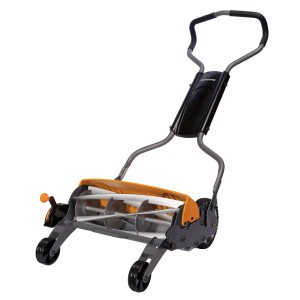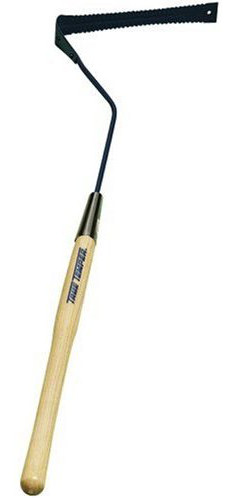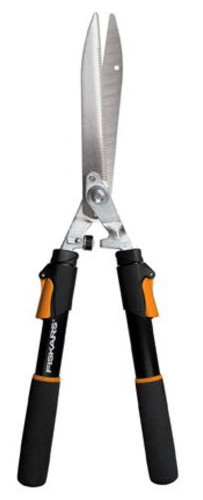Last Saturday, after my customary cup of homemade iced coffee – as is typical for me on a hot Texas summer morning – I gazed out the window and decided it was high-time to attack the grass, which has been growing with reckless abandon since we actually had a few drops of rain recently. Rain can be a rarity in south TX, so I don’t begrudge the grass its growth, but I knew I had to do something about it.
Some of my neighbors reached the same conclusion, and before I could drain the java I could hear their yard work commence as they fired up their lawn mowers, edgers, weed whackers, and leaf blowers. Thus, the Saturday-morning noise pollution began.
Not from me, though. I’ve never owned a “typical” lawn mower. For years, I’ve used one of those old-fashioned reel mowers, and I’ve written about it before. I ended up selling that old mower a few years ago when I moved to an apartment, but now that I’m a homeowner again, I’ve picked up a great new grass-slicing machine. But before I get too far ahead of myself….
3 Indispensable Zero-Emission Yard Tools
I have three zero-emission tools that I use for practically all of my regular lawn maintenance. The zero-emission part is critical in part (and only in part) because I care about the environment. More importantly, I’m selfish: These three tools are inexpensive (mostly), and when it comes to things like lawn equipment, the last thing I want to do is sink money into items that will require continued expenses in the form of gasoline, oil changes, and tune-ups. I feel bad enough that my car meets that requirement, though I can sheepishly justify it because it takes me to work, and work pays me money every month. Mowing my own lawn doesn’t directly give me money (though it does indirectly by not having to pay someone else).
All three items were purchased new and I expect them to each last 10+ years with little or no maintenance.
The Reel Mower
 And here’s my pride and joy: My Fiskars 18-Inch Reel Lawn Mower
And here’s my pride and joy: My Fiskars 18-Inch Reel Lawn Mower
This little baby makes short work of my mixed-grass lawn. When I moved in last year, the builder put down new bermuda-grass sod, but due to the Texas drought, most of it died. What little survived has spread rapidly this year, coexisting well with some other native grass that sprung up. My reel mower devours all of it, even if I’m lazy and wait a little too long before I cut the grass.
With a reel mower, you have to change your entire perspective on how grass is cut. Gas-powered mowers have a blade that spins laterally, tearing through the grass. Reel mowers trim from the top-down, so it’s like giving your lawn a haircut. You have to remember that YOU are the power behind the blades – the faster you walk, the faster the blades spin (though I find it cuts more efficiently at a medium-slow walk).
Is it easy to start? Haha, yes. Just start pushing; no pull-chords to yank. Is it easy to push? Yes and no. I’m six-feet tall and not particularly muscular, and I’ve never had to give up in frustration. If you’re tackling a neglected lawn where the grass blades are stretching toward your kneecaps, then this isn’t the mower for you. Better get a scythe for that (see below). On the other hand, I’ve waited 2+ weeks during mowing season before outright shame forced me to drag the mower out of the garage, and I’ve still not had trouble. If you’re an 80-pound weakling, then it’s time to hop off that riding mower and build some strength with your new reel mower!
Does it take extra time? Not really. I live in a typical suburban home on a corner lot, and it takes me about 75-90 minutes to mow my lawn. With a gas-powered push mower, I could probably get that down to an hour, but at what cost? I’ll gladly spend the extra few minutes to not have to keep extra gasoline in my garage and to never have regular recurring maintenance. Plus, I get a light workout each time I push the orange beast through the grass. Oh, and instead of firing up a leaf blower to blow the grass clippings off the driveway and sidewalk, I just grab a broom.
My favorite part: Watching the torrent of clippings fly forward from the orange discharge chute at the top as the blades emit a satisfying whirring sound! This keeps the clippings from getting all over your feet. It’s quiet, too. I can mow my lawn at night if I want. My other favorite part: Seeing the bewildered looks on my neighbors’ faces when they see me cutting my lawn. Sometimes I get looks of pure pity. Yeah, I pity those fools who have to keep buying gas for their fume-belching, noise-polluting lawn munchers. I get the same job done with full environmental benefits and none of the extra monetary costs. Suckers.
The Grass Whip
 Up next we have an unusual and old-fashioned tool: my Ames Serrated Grass Whip
Up next we have an unusual and old-fashioned tool: my Ames Serrated Grass Whip
This bad boy resembles a scythe, but instead of a hooked blade, it has a straight, serrated edge that does wonders on tall weeds and grass. I use it to demolish the occasional patch of tall weeds, but mostly I use it as a replacement for a string trimmer.
After I mow my lawn, I’m left with the inevitable thatches of remaining tall grass that line my fence, the flowerbeds, and my house’s foundation. That’s when I grab the grass whip, which I’ve personally dubbed Grassbane: The Leveler. If you’ve ever played golf, you’ll feel right at home with this tool, as you can swing it like a driver and wreak havoc on tall grass. You just have to aim carefully so as to not damage the fence, the foundation, or the scythe.
I’m able to move surprisingly quickly with the whip, and it’s great fun to watch the grass fly skyward with each stroke. The looks of pity that my neighbors give me regarding the reel mower turn to pure perplexity (with a hint of fear) as I march about my yard, Grassbane held aloft. (For the record, my grass whip has yet another function: I keep it under the bed when not in use, stored as a home security tool. If someone breaks into my house, they’ll have to contend with Grassbane, and if I were a burglar, I’d flee in terror if someone charged me with a scythe. What can I say? When you’re holding a grass whip, everything starts to resemble a giant weed.)
The only downside to the grass whip is that it’s impossible to get a perfect cut against a fence or a house foundation. I can clear out probably 80% of it, but some strands of grass always remain, waving in the wind and mocking you. That’s when I pull out the next tool.
The Shears
 And this brings us to the final tool: my Telescoping Power-Lever Hedge Shear
And this brings us to the final tool: my Telescoping Power-Lever Hedge Shear
This versatile tool plays many roles, the most obvious of which is to trim hedges.  My wife and I use it to trim most everything in the yard, especially our sage bushes that seem to triple in size each year, as well as our hearty thickets of lantana that are doing a bang-up job of convincing us that they’re actually kudzu in disguise. We can even cut small tree limbs with this set of shears since the handles have a telescopic extension.
My wife and I use it to trim most everything in the yard, especially our sage bushes that seem to triple in size each year, as well as our hearty thickets of lantana that are doing a bang-up job of convincing us that they’re actually kudzu in disguise. We can even cut small tree limbs with this set of shears since the handles have a telescopic extension.
I use it as a follow-up to my grass whip, eliminating any remaining strands of grass by the fence, flowerbeds, and foundation. Sure, it’s less convenient than a string trimmer, but it gets the job done, and I don’t have to deal with all the typical annoyances of a string trimmer.
I even use the shears to cut the little runners of grass that stretch out over the driveway and sidewalk. No, it’s not a perfect edger, but the results are good enough, and I just wipe the dirt off the blades afterward.
Summary
Between those three tools, I can take care of 90%+ of all routine yard work, and I personally feel no need for gas-powered machines when these simple tools can get the job done. Yes, they make take a little longer time to use, but what are you going to do with that extra half-hour anyway? Sit on your butt in front of the TV? I’ll gladly spend that extra time outdoors, working with my hands, and saving a bundle of money in the process.
And this leads us to the heart of the matter: how much are all those gas-powered tools really costing you, anyway? These three tools currently cost $246 brand new and have zero regular maintenance costs. At best, you might have to sharpen the blades every five years or so. How much does a new lawn mower, a string trimmer, a leaf blower, and possibly an edger cost? And how much will you spend in gasoline and other expenses each year, including buying the gas tank and driving to the gas station? Actual numbers vary, of course, but let’s estimate a $500 initial cost and a $50 yearly ongoing cost, which is likely a low-ball estimate. By that estimate, you paid an extra $254 for your gas-powered machines upfront than I did for my manual tools.
Over a ten-year period, counting your recurring costs and assuming that the extra money could have been invested instead (earning 6% on average), your extra total cost is $1,153. Is the extra convenience of having gas-operated machinery worth over a grand every ten years?
Not to me. I’ll keep my manual tools and the inconvenience of having to exert a little effort when I take care of my yard. I’ll also keep the inconvenience of never having to make an extra trip to the gas station because my lawnmower died mid-yard, or of having to deal with the typical maintenance of an internal-combustion engine.
If you’re my neighbor, you can stop the looks of pity. I’m fine. For my part, I’ll do my best to stop the looks of smugness as you desperately yank the pull-chords over and over as you try to start your noise-polluting machines. 